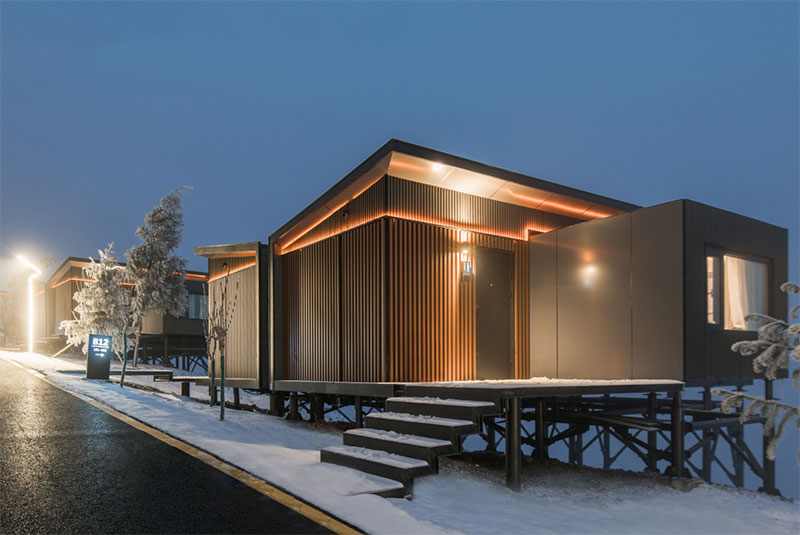Advantages of Simple Light Steel Container Hotel Houses
In the fields of cultural tourism, emergency accommodation, and scenic area facilities, Simple Light Steel Container Hotel Houses, with their modular design and technological advancements, are gradually replacing traditional construction and becoming a mainstream choice. This innovative design, combining a light steel frame with container modules, retains the stability of steel structures while maintaining the flexibility of modular construction. Its multi-dimensional advantages have been proven in numerous real-world projects.

Structural Safety: Disaster Resistance Far Exceeds Traditional Buildings
The safety of simple light steel container hotel buildings stems from the dual guarantees of a light steel frame and container structure. The main structure utilizes SGS-tested light steel keels, which form a composite load-bearing system with sandwich wall panels. This structure is designed to withstand typhoons of magnitude 9-11 and a magnitude 7 earthquake, and performs particularly well in earthquake-prone areas or coastal scenic spots. The container surface is treated with an anti-corrosion spray coating and sealed with EPDM waterproofing strips, providing excellent waterproof and moisture-proof properties, ensuring a dry interior even in rainy and humid environments. These structural features make them suitable for a variety of complex terrains: mountainous scenic areas can be quickly constructed using elevated foundations, while flood-prone areas utilize elevated designs to prevent flooding. The low deadweight of light steel (only one-quarter that of brick-concrete structures) significantly reduces foundation construction requirements, even requiring no complex foundation preparation. Authoritative testing indicates that the main structure has a design lifespan of over 25 years, and its components are reusable, maintaining stable performance after secondary assembly.
Deployment Efficiency: Rapid Construction Reduces Construction Time by Over 50%
"Ready-to-use" is one of the most significant advantages of light steel container hotel buildings. Their core components are standardized and manufactured in the factory. On-site, only module assembly and plumbing connections are required. Six skilled workers can complete the installation of a 100-square-meter space in three days, and the renovation of a single container suite can be completed in as little as one day. Compared to the 6-12-month construction period of traditional brick-concrete hotels, this type of modular building can shorten the construction period by 50%-70%, making it particularly suitable for cultural tourism projects with tight construction deadlines or emergency accommodation needs. Transportability further enhances deployment efficiency: Standard container modules can be transported by road, rail, and sea, making them easily accessible even to remote scenic spots or outdoor locations. Upon completion, the modules can be relocated and reassembled at a new site, achieving a "zero-trace" evacuation process. They are ideal for temporary accommodation scenarios such as campsites and music festivals.
Cost Advantage: Highlighted Lifecycle Affordability
From initial investment to ongoing maintenance, lightweight steel container hotel buildings offer cost advantages throughout their entire lifecycle. In terms of materials, the cost of a single 20-foot standard module is only 60%-70% of that of a brick-concrete building of the same size. Construction requires no large machinery, and labor costs are over 40% lower than traditional construction. Industry data indicates that the overall construction cost of this type of hotel can be kept between 1,500 and 2,500 yuan per square meter, making it more competitive with similar products such as lightweight steel villas. Long-term maintenance costs are also manageable: the anti-corrosion coating on the light steel frame has a maintenance cycle of 15-20 years, with an average annual maintenance cost 40% lower than that of ordinary container buildings. The modular structure allows for local repairs without shutting down the entire project, and vulnerable parts such as doors, windows, and wall panels can be quickly replaced, further reducing operational losses. Its "low-cost, fast-return" feature is particularly prominent for small and medium-sized cultural and tourism projects with limited budgets.
Environmental Value: A Practical Example of Green Construction
The environmentally friendly attributes of light steel container hotel buildings are reflected in two key aspects: material recycling and the construction process. The container modules are recyclable. Recycling one used container saves 1.7 tons of steel and 0.4 cubic meters of wood, reducing carbon dioxide emissions by 3.49 tons. Using recycled containers for renovation reduces carbon emissions by over 60% compared to traditional construction.
Near-zero waste operation is achieved during the construction phase: Factory prefabrication reduces on-site construction waste by 80%, and the dry construction method eliminates the need for cement mortar, eliminating dust pollution and wastewater discharge at the source. Combined with green technologies such as solar power and rainwater harvesting, it achieves energy self-sufficiency. Energy consumption in some scenic area projects has been reduced to less than 40% of that of traditional hotels, fully meeting the low-carbon development needs of the modern cultural tourism industry.
Spatial Adaptability: Flexible Functional Extensibility
The modular nature of the system allows for significant spatial flexibility. A single unit can serve as a standard guest room (approximately 18 square meters), horizontally connected to create suites or public living rooms, and vertically stacked to create buildings of three or more stories, catering to a range of scales, from boutique B&Bs to large hotels. The interior layout is customizable: partitions, doors, windows, and ceilings can all be flexibly adjusted, and even complete functional modules such as kitchens and bathrooms can be integrated, achieving a "move-in ready" delivery standard.
This flexibility makes it suitable for diverse scenarios: scenic areas can create decentralized viewing rooms, quickly set up temporary reception centers during exhibitions, and rapidly deploy emergency accommodation after disasters. A UK project constructed a hotel headquarters using 11 shipping containers. The entire process, from design to operation, was completed in just four months. Later, the space was expanded by 30% through the addition of new modules, fully demonstrating its "customizable and scalable" advantages.
Living Experience: Performance Upgrades Comparable to Traditional Hotels
Through technological optimization, the living comfort of light steel container hotel accommodations has achieved a qualitative leap. Regarding insulation, the interior of the container utilizes polyurethane spray foam technology, achieving a thermal conductivity as low as 0.022W/(m・K). Combined with triple-layer insulating glass and thermally insulated aluminum profiles, winter insulation energy consumption is reduced by 60%. Sound insulation is achieved through a "gypsum board + centrifugal glass wool" composite wall, reducing noise by over 30 decibels and completely isolating the space from outdoor interference.
Detailed design further enhances the experience: the roof features a sloped drainage design to prevent water accumulation, the floor is covered with rubber soundproofing mats to absorb footsteps, and the sealed joints of the container effectively prevent moisture intrusion. Actual measured data shows that its indoor temperature stability and sound insulation have reached the standards of a three-star hotel, and the good lighting and visual advantages brought by the lightweight design have become a unique selling point of the cultural and tourism project.


